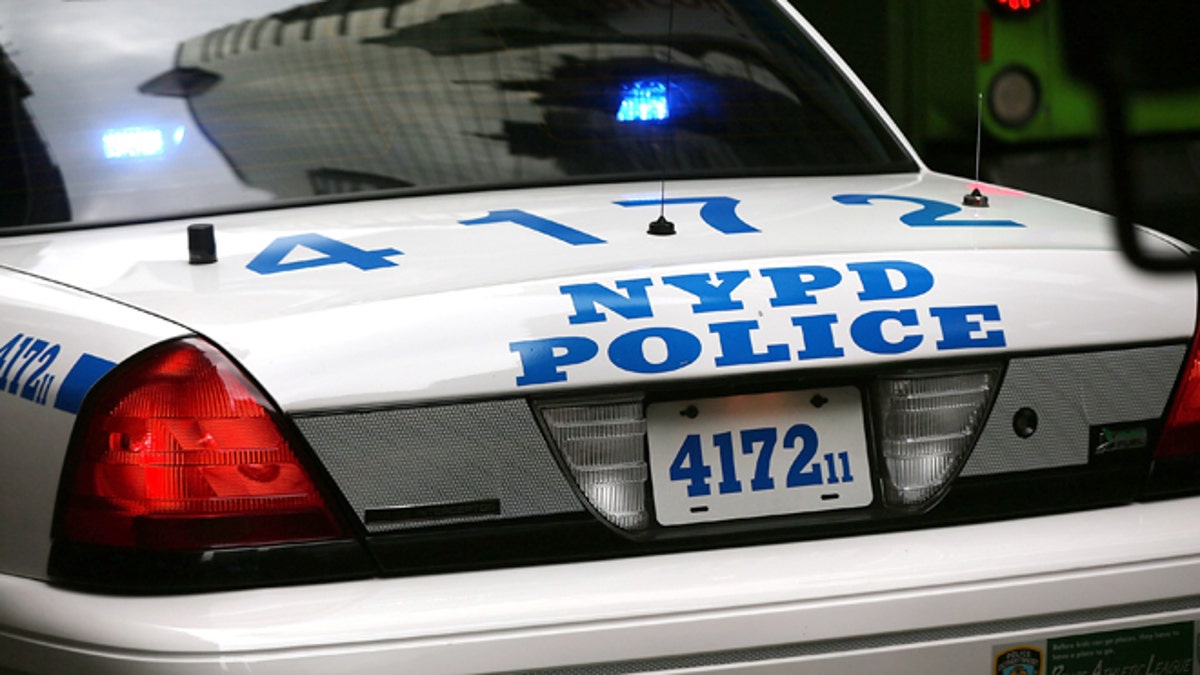
NEW YORK, NY - AUGUST 12: A New York Police Department (NYPD) car is viewed in Times Square on August 12, 2013 in New York City. The controversial policy employed by the NYPD in high crime neighborhoods known as stop and frisk has been given a severe rebuke by a federal judge on Monday. U.S. District Court Judge Shira Scheindlin has appointed an independent monitor to oversee changes to the NYPD's stop and frisk tactic's after finding that it intentionally discriminates based on race. Both New York Mayor Michael Bloomberg and New York City Police Commissioner Raymond Kelly. (Photo by Spencer Platt/Getty Images) (2013 Getty Images)
New York – The New York City Police Department is set to announce a pilot program for equipping officers with body cameras following an order by a federal judge who ruled that blacks and Latinos are disproportionately targeted and frisked in the Big Apple.
A similar measure was implemented earlier this week in Ferguson, Missouri, weeks after a police officer there shot and killed 18-year-old Michael Brown.
In New York City, public advocate Letitia James has been a vocal supporter of the initiative.
"This summer we've seen some really powerful images in Missouri and New York City in the aftermath of … Michael Brown and Eric Garner,” James said, according to the Wall Street Journal. Cameras, she said, "would go a long way toward providing an objective record of what happened either before or after an incident."
A judge ruled last year that the New York Police Department had discriminated against blacks and Hispanics when stopping, questioning and sometimes frisking people on the street. The judge ordered major reforms to the department's implementation of the policy.
Then-Mayor Michael Bloomberg appealed the decision, but current mayor Bill de Blasio, who took office at the beginning of the year, is now seeking to drop the appeal.
The use of technology to try to identify problem officers before their misbehavior harms innocent people, embarrasses their employer, or invites a costly lawsuit has taken off in recent years.
While such "early warning systems" are often treated as a cure-all, experts say, little research exists on their effectiveness or — more importantly — if they're even being properly used.
Over the last decade, such systems have become the gold standard in accountability policing with a computerized system used by at least 39 percent of law enforcement agencies, according to the most recent data from the U.S. Bureau of Justice Statistics.
The issue of police-community relations was thrust into the spotlight after an officer fatally shot Michael Brown in Missouri. Since then, departments have held public forums to build trust with residents. Some are testing cameras mounted to officers to monitor their interactions with the public.
Experts say the early warning system can be another powerful tool to help officers do their jobs and improve relations, but it is only as good as the people and departments using it.
"It's not a guarantee that you will catch all of those officers that are struggling," said Jim Bueermann of the nonprofit Police Foundation, which is dedicated to better policing. "These systems are designed to give you a forewarning of problems and then you have to do something."
The aim is to avoid cases where the first evidence of a troubled officer is a YouTube video showing them excessively beating a suspect. Such incidents stoke public fears about police and can result in huge monetary settlements.
The systems track factors such as how often officers are involved in shootings, get complaints, use sick days and get into car accidents. When officers hit a specific threshold, they're supposed to be flagged and supervisors notified so appropriate training or counseling can be assigned.
Some law enforcement agencies adopted the systems under agreements they entered into with the federal government after officers were accused of abuse, including departments in Seattle, which is currently working to implement such a system, and Los Angeles.
The Los Angeles Police Department agreed to set up their $33 million early warning systems after the so-called Rampart scandal in which an elite anti-gang unit was found to have beaten and framed suspected gang members. The system was then implemented in 2007.
The LAPD's inspector general found in a recent review that the system was seemingly ineffective in identifying officers who ultimately were fired. The report looked at 748 "alerts" over a four-month period and found the agency took little action in the majority of cases and only required training for 1.3 percent, or 10 alerts, of them.
Sam Walker, a University of Nebraska at Omaha professor emeritus and expert on such systems, said he was troubled by the department's response to the report and concerned their follow-up study would be used to discredit the system a year after emerging from federal oversight.
"These are not predictive devices," he said. "Is the failure in the system itself or is the failure in how the department managed the system. If they did such a small amount of retraining did they ignore lots of training needs and fail to do it?"
Maggie Goodrich, the LAPD's chief information officer, defended the technology before the department’s civilian oversight board but also said a deeper analysis of its impacts is necessary. "How do you prove a negative?" she asked. "What we can't capture with this system is how many times have we stopped somebody from engaging in behavior?"
The Associated Press contributed to this report.
Follow us on twitter.com/foxnewslatino
Like us at facebook.com/foxnewslatino
